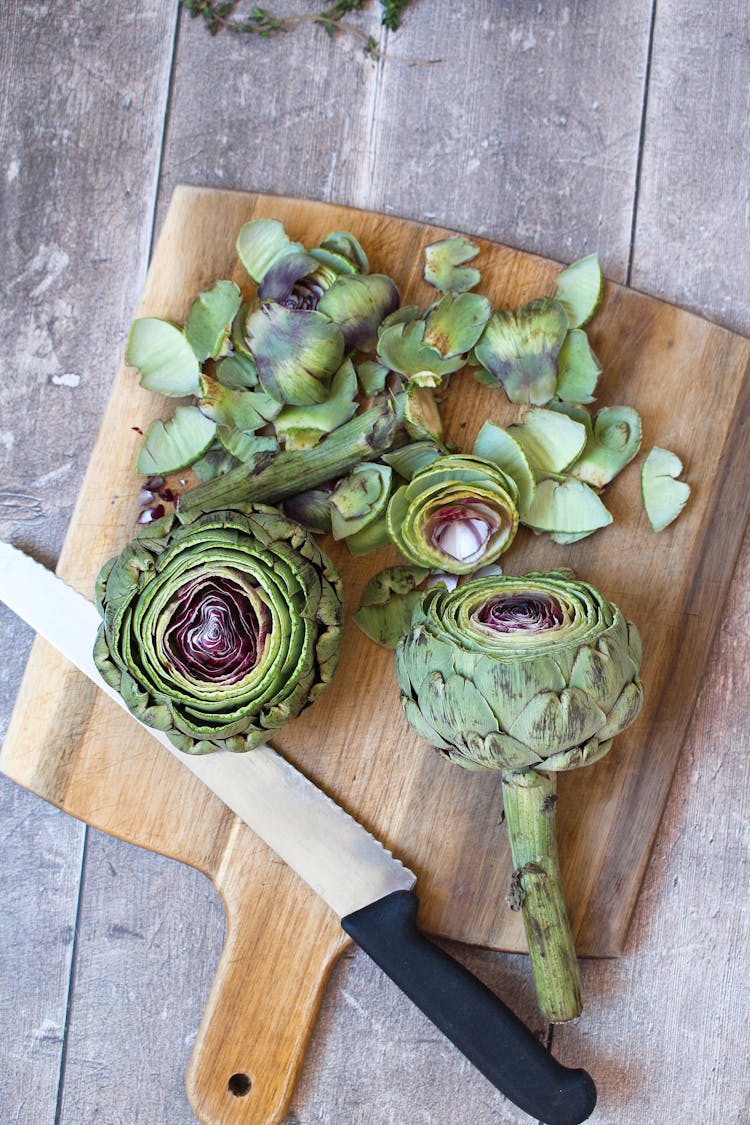Recipes for your artichoke leaves
Most artichoke recipes ask for the heart of the artichoke and discard the rest of the plant because it's 'too tough'. You will need to discard the 'choke', toughest outer leaves and stiff tips of the leaves. But the bases of the leaves are meaty and tender, and the innermost leaves can be edible in their entirety.
Here are some useful ideas and recipes for how to use artichoke leaves. And if you don't want to cook with your leaves straight away, freeze them for later on.

BOIL THEM TO MAKE A STOCK
Peel off the leaves and chop off their hard tips. Wash the fleshy parts and put them into a soup pot with enough water to cover. The leaves will naturally float, so gauge this as best you can. Add in your preference of stock flavourings, like garlic, rosemary or thyme. Boil for 20-30 mins until the leaves are soft and edible. Boil the water down further for a more intense flavour.
- To transform this into a soup: Slice 1 potato and cover by an inch with your broth. Boil the potato for 20 mins or until it's soft enough to mash. Add in more aromatics or stock as needed, and blend to make into soup.
(via Jenna Edwards)
BLEND THEM
Boil the leaves for 1 hour, then separate the fleshy parts of the leaves. Discard the harder tips and leaves. Use the pulp that remains to blend into one of three mixtures.
- To make artichoke hummus: Mix the pulp in a blender with chickpeas, lemon, mint, olive oil, salt and pepper for a unique hummus dip.
- To make artichoke cream: Blend your artichoke leaf pulp with 1 tbsp of soy cream or olive oil, whichever you prefer. Season with salt and pepper.
- To make artichoke mayonnaise: Make your mayonnaise base by mixing 2 parts vegetable oil, 1 part soy milk, a dash of lemon juice and a pinch of salt. Blend with your artichoke pulp to create a smooth mayonnaise dip.
(via The Plantbased School)
CARAMELISE THEM
Heat a frying pan on medium heat with a generous amount of olive oil. Add the leaves and stalk from the artichoke with a whole peeled garlic clove. Season with sea salt. Fry for a few mins, then add a little white wine and cover. Simmer in the wine until the leaves become tender, ensuring the pan doesn't become dry.
After 5 mins, remove the lid to evaporate any remaining wine. Add another helping of olive oil and fry gently until the leaves caramelise. Eat the leaves by pulling the flesh off with your teeth.
(via The Guardian)
ROAST THEM
Heat the oven to 190°C/170°C fan/375°F and bring a large pot of water to the boil. Gently remove the tough outer leaves from the artichokes and save them for later. Stop once only the more tender, lighter-coloured leaves directly above the heart are left. Save the rest of your artichoke for another recipe. Add the artichoke leaves to the boiling water and cook for about 8-10 mins, until their fleshy bases are tender (test this).
Meanwhile, sprinkle a little sea salt over 1 clove of garlic and smash it until it becomes a garlic paste. Whisk together with 1 tbsp lemon juice and a dollop of mayonnaise. Adjust the quantities of these 3 ingredients until your aioli tastes just right to you.
Drain the leaves and place them on a baking tray with their insides facing upwards. Discard any that seem still too tough to eat or are missing fleshy bases. Sprinkle 50g feta (or a vegan alternative) and 70g black olives across the leaves. Bake for 8-10 mins, until everything is only just heated through. Remove from the oven and top with your homemade aioli. To eat, scrape off the toppings and tender bases of the leaves with your teeth.
(via Food52)
SERVE THEM RAW
Recipes for artichoke leaves usually involve cooking them, but their bases are safe to eat raw too. You can make a carpaccio from the larger artichoke leaves by simply cutting out the flesh from the base of each and dressing it with lemon, olive oil, seasoning and hard cheese (or nutritional yeast).

